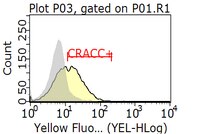MABF917 Sigma-AldrichAnti-CRACC Antibody, clone 4G2
Anti-CRACC Antibody, clone 4G2 is an antibody against CRACC for use in Flow Cytometry, Affects Function, Immunoprecipitation.
More>> Anti-CRACC Antibody, clone 4G2 is an antibody against CRACC for use in Flow Cytometry, Affects Function, Immunoprecipitation. Less<<Produits recommandés
Aperçu
| Replacement Information |
|---|
Tableau de caractéristiques principal
| Species Reactivity | Key Applications | Host | Format | Antibody Type |
|---|---|---|---|---|
| M | FC, FUNC, IP | R | Purified | Monoclonal Antibody |
| References |
|---|
| Product Information | |
|---|---|
| Format | Purified |
| Presentation | Purified rat monoclonal IgG1κ antibody in PBS without preservatives. |
| Quality Level | MQ100 |
| Physicochemical Information |
|---|
| Dimensions |
|---|
| Materials Information |
|---|
| Toxicological Information |
|---|
| Safety Information according to GHS |
|---|
| Safety Information |
|---|
| Packaging Information | |
|---|---|
| Material Size | 100 μg |
| Transport Information |
|---|
| Supplemental Information |
|---|
| Specifications |
|---|
| Global Trade Item Number | |
|---|---|
| Référence | GTIN |
| MABF917 | 04055977349627 |
Documentation
Anti-CRACC Antibody, clone 4G2 FDS
| Titre |
|---|
Anti-CRACC Antibody, clone 4G2 Certificats d'analyse
| Titre | Numéro de lot |
|---|---|
| Anti-CRACC, clone 4G2 -2775314 | 2775314 |
| Anti-CRACC, clone 4G2 -Q2676858 | Q2676858 |
| Anti-CRACC, clone 4G2 Monoclonal Antibody | 2938795 |
| Anti-CRACC, clone 4G2 Monoclonal Antibody | 2885167 |







